NEWS Alberta government to announce new COVID (2020)measures this afternoon
NEWS — Alberta government to announce new COVID (2020)measures this afternoon
An announcement will come today on new measures intended to slow the spread of COVID-19 in Alberta.
Premier Jason Kenney, Health Minister Tyler Shandro, Chief Medical Officer of Health Dr. Deena Hinshaw and Dr. Verna Yiu, CEO of Alberta Health Services, will be at today’s COVID-19 briefing to provide an update on the pandemic and the province’s response.
https://www.milesplit.com/discussion/171087
https://dcm.shivtr.com/forum_threads/3273436
https://thesanguy.com/forum-mobile/topic/news-alberta-government-to-announce-new-covid-measures-this-afternoon
https://www.guest-articles.com/others/alberta-government-to-announce-new-covid-19measures-this-afternoon-24-11-2020
https://newsjapanin.blogspot.com/2020/11/news-alberta-government-to-announce-new.html
https://movienews.substack.com/p/covid-19-alberta-government-to-announce
http://www.justaaa.com/topic.php?tid=294421
https://caribbeanfever.com/photo/albums/tyfjgchgnebrdcfb-nrtb-t
http://facebookhitlist.com/forum/topics/vgffhnfdcwerfghredfg
http://officialguccimane.ning.com/profiles/status/show?id=3685062%3AStatus%3A51797310
https://www.posts123.com/post/910349/watch-tenet-2020-full-hd
http://www.4mark.net/story/2841856/(watch)-tenet-2020-full-hd
https://www.topfind88.com/post/910350/watch-tenet-2020-full-hd
https://note.com/sdfgbnerdf/n/n6bdb6a53d2a2
http://paste.jp/4427910c/
https://friendpaste.com/39HnuLAeJbnyDcbA2S0pnX
https://paiza.io/projects/gTQ5Zsh6rhrMQrIii5JMhg?language=php
http://www.mpaste.com/p/z3
https://onlinegdb.com/rJb5E-jcv
https://slexy.org/view/s2YISjCuRx
http://notes.io/MLkn
https://sites.google.com/view/alberta-government-to-announce
https://superbate.medium.com/news-alberta-government-to-announce-new-covid-2020-measures-this-afternoon-ed8d88fa4cd2
https://blog.goo.ne.jp/firsteverythingme/e/16413b02c0f2c9f10cf99ae52ac9ab04
https://newsfortodays.hatenablog.com/entry/2020/11/25/070217?_ga=2.54728493.761534763.1606255348-1117400537.1606255348
https://newsflu.tumblr.com/post/635704839965376512/yugyivuhyfghvhvgb
https://www.hybrid-analysis.com/sample/f69c96b8de8809f44e559e406b0a7dd2455adb62e6ac5448b7210b0eb13d8b50
https://www.peeranswer.com/question/5fbd80e09e41a7d666dede1f
The news conference has been scheduled for 4:30 p.m. MT. You can watch the briefing here.
In a noon-hour tweet Tuesday, Kenney confirmed that he, Hinshaw and Shandro will announce new measures “that will help Alberta slow the spread” of COVID-19.
“We must act together to stop the spike, protecting both lives and livelihoods,” Kenney wrote.
Albertans have been bracing for new restrictions, as cases continue to surge rapidly.
As of Monday, the province had 13,166 active cases, more than any other province in Canada. In her briefing Monday, Hinshaw warned that cases are escalating out of control.“This is like a snowball rolling down a hill, growing bigger and faster, and it will continue unless we implement strong measures to stop [it]. We must take action,” Hinshaw said Monday.
“Waiting any longer will impact our ability to care for Albertans in the weeks and months ahead.”
Hinshaw cut Monday’s briefing short to meet with Premier Jason Kenney and the priorities implementation cabinet committee to discuss recommendations to reduce the caseload.
Alberta reported 1,549 new COVID-19 cases on Monday. It was the fifth consecutive day with numbers above the 1,100 mark. There were 328 patients in hospital, 62 of them in intensive care. The death toll stood at 476.
Daily caseloads have more than doubled in recent weeks. In the first week of November, there were just under 600 new cases a day.
- ‘We have reached a precarious point’: Alberta now has 13,166 active cases of COVID-19
- ‘A deep, dark sense of foreboding’ as Alberta braces for surge of COVID-19 illness and death
On Sunday, Alberta led the entire country with 1,584 new cases, despite having a fraction of the population of Ontario and Quebec. Front-line doctors and epidemiologists have called for a shutdown of businesses and activities to reverse the trend.
On Saturday, in a Zoom call with the Canada India Foundation, Kenney said new health restrictions are likely to come but he continued to reject a sweeping shutdown as intrusive and ineffective.
“We will likely have to take some more restrictive measures, given the current direction of things here. Because, ultimately, our goal is to protect the health-care system from being overwhelmed while minimizing damage to the broader social, economic, mental, emotional and physical health of society,” he said.
“We are not exclusively focused on COVID-19. We understand that for every policy in response to it, there are unintended consequences, so we’ve taken a holistic approach, and we believe that that has been effective.”
Covid-19 Live Updates: Thanksgiving Travel Drops as Americans Rethink Rituals
The leader of France says the country is past the peak of the second wave. A surge in California is shattering records. Pennsylvania bans alcohol sales past 5 p.m. on Wednesday, in a bid to stop pre-Thanksgiving partying.
RIGHT NOW
The surge in California shatters records as officials scramble to head it off.
Here’s what you need to know:
- Holiday travel drops, as Americans rethink a comforting ritual.
- Pennsylvania bans booze sales on one of the busiest nights of the year.
- Macron says that France is past the peak of the second wave and that shops can reopen on Saturday.
- In the first distribution push, 6.4 million doses of Pfizer’s vaccine will be shipped across the U.S.
- Britain will loosen most restrictions for a short period to allow people to celebrate Christmas.
- For Biden, the start of the transition means his battle against the coronavirus begins.
- The organizers of a gigantic Brooklyn wedding will be fined $15,000 for violating pandemic rules.
Holiday travel drops, as Americans rethink a comforting ritual.


Passengers waited for flights at La Guardia Airport in Queens on Monday. The AAA has forecast a 10 percent overall decline in Thanksgiving travel compared with last year.Credit…Victor J. Blue for The New York Times
Americans have agonized over Thanksgiving this year, weighing skyrocketing case numbers and blunt warnings from the Centers for Disease Control and Prevention against the need, after a grim and worrying year, to gather with family for a traditional, carbohydrate-laden ritual.
Around 27 percent of Americans plan to dine with people outside their household, according to interviews conducted by the global data-and-survey firm Dynata at the request of The New York Times.
Views on whether to risk Thanksgiving gatherings appear to track closely with political views, with respondents identifying as Democrats far less likely to be planning a multihousehold holiday.
Megan Baldwin, 42, had planned to drive from New York to Montana to be with her parents, but last week, she canceled her plans.
“I thought I would get tested and take all the precautions to be safe, but how could I risk giving it to my parents, who are in their 70s?” she said, adding that they were not happy with the decision.
“All they want is to see their grandkids,” she said, “but I couldn’t forgive myself if we got them sick. It’s not worth it.”
Others decided to take the plunge, concluding that the emotional boost of being together outweighed the risk of becoming infected.
“We all agreed that we need this — we need to be together during this crazy, lonely time, and we are just going to be careful and hope that we will all be OK,” said Martha Dillon, who will converge with relatives from four different states on her childhood home in Kentucky.

A Detailed Map of Where Americans Are Staying Home for Thanksgiving
Thanksgiving travel is clearly down compared with 2019.
The AAA has forecast a 10 percent overall decline in Thanksgiving travel compared with last year, the largest year-on-year drop since the recession of 2008. But the change is far smaller, around 4.3 percent, for those traveling by car, who make up a huge majority of those who plan to travel — roughly 47.8 million people.
About 917,000 people were screened by the Transportation Security Administration on Monday, less than half of the number seen on the same day in 2019, according to federal data published on Tuesday.
Demand for travel by train is down more sharply, at about 20 percent of what it was last year, said Jason Abrams, a spokesman for Amtrak.
Susan Katz, 73, said she canceled plans to spend Thanksgiving with her daughter last Friday, after watching a monologue by Rachel Maddow, the MSNBC host, describing her partner’s bout of coronavirus and her fear that it would prove fatal.
“Her emotion, Rachel Maddow’s emotion, made it so real, it just moved us,” Ms. Katz said. “I probably called her within a few hours of seeing that.”
Ms. Katz, who lives in Raleigh, N.C., said she will spend the holiday alone with her husband. She is trying to decide whether to bother thawing a turkey breast.
Warnings from experts swayed Laura Bult, 33, to cancel her Sunday flight to St. Louis two days before she was scheduled to leave.
“I’m on Twitter — there’s a lot of travel-shaming going on,” she said. “Doing the small part of being one less person circulating through an airport felt important enough to me.”
Her decision, she said, means her mother will be alone for the holiday.
“I really wanted to be with my mom,” she said. “I was trying to be careful because of her. She is not looking out for her best interests, because she just wants to see me.”
Interest in travel generally has increased after recent announcements by pharmaceutical companies that their coronavirus vaccine candidates have been effective at preventing infections, according to preliminary data.
Travel bookings increased by about 25 percent after Pfizer said in early November that a vaccine it was developing with BioNTech was more than 90 percent effective, according to Skyscanner, a travel search engine.
Dr. Anthony Fauci, the country’s top infectious-disease expert, has strongly discouraged holiday travel as the number of new infections surges across the country
“Do you really want to have that gathering?” he said, in an interview with PBS. “Or should you say, I know it hurts not to do it, because this is such a beautiful, traditional season, but hang in there with us, because there will be future times when you can do it?”
— Ceylan Yeginsu, Ellen Barry, Vikas Bajaj and Cora Engelbrecht
Tracking the Coronavirus ›
United StatesOn Nov. 2314-day
changeTrendNew cases179,067+49%New deaths1,032+62%WorldOn Nov. 2314-day
changeTrend528,385+6%8,420+20%
Where cases per capita are highest
N.D.Wyo.N.M.S.D.Minn.IowaMont.Wis.Neb.UtahKan.Ind.R.I.Ill.Colo.
U.S. hot spots ›

College cases ›

Worldwide ›

The surge in California shatters records as officials scramble to head it off.


Some people brought lawn chairs as they waited in line to take Covid tests in Los Angeles on Tuesday.Credit…Bryan Denton for The New York Times
As Gov. Gavin Newsom of California was briefing reporters on a video conference call on Monday, he stopped to cough. He started to say something more, and coughed again. Then he paused and smiled.
“That’s tea that got in my throat,” he said. “Nothing more.”
It was only natural to wonder. The realities of the coronavirus surge that has reached every corner of California had just penetrated the governor’s mansion as well: Mr. Newsom and his family had gone into quarantine early that morning because three of his children had been in contact with someone who later tested positive.
California reported 17,694 new cases on Monday, well more than it or any other state had ever done before, according to a New York Times database. Over the past week, it has averaged 12,712 new cases a day — more than Maine’s total for the whole pandemic. And the trajectory in California has lately been almost straight up.
With infections and hospitalizations each rising at an alarming rate in the state, officials announced a curfew late last week for counties in the state’s purple reopening tier — in other words, the counties where almost all of the state’s nearly 40 million residents live.
Officials have implored Californians to take precautions and to reconsider traveling, even within the state. And some local officials have gone further, including closing down outdoor dining in Los Angeles “to reduce the possibility for crowding and the potential for exposure” — an order that takes effect on Wednesday and has drawn pushback.
California is far from the only state where new case reports are shattering records. Oregon hit a new daily high on Sunday, Wyoming did so on Monday, and three states — Rhode Island, Connecticut and Kansas — that do not report separate daily figures over weekends set records for three-day periods ending Monday.
As of Monday night, 11 states — Kansas, Wyoming, Nebraska, Kentucky, Minnesota, Idaho, Tennessee, Illinois, Oklahoma, Indiana and South Dakota — had added more deaths in the last week than in any other week since the pandemic began.
ADVERTISEMENT
Continue reading the main story
Pennsylvania bans booze sales on one of the busiest nights of the year.

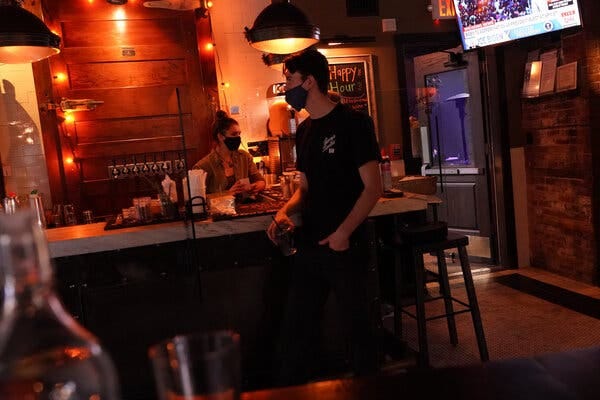
The night before Thanksgiving is usually a busy one in Pennsylvania’s drinking spots, but they will have to stop serving at 5 p.m. this year, the state has ordered.Credit…Michelle V. Agins/The New York Times
Bars and restaurants in Pennsylvania have been ordered by the state to stop selling alcohol at 5 p.m. on Wednesday, in an effort to head off uninhibited pre-Thanksgiving gatherings where the coronavirus could spread rapidly.
“It turns out, the biggest day for drinking is the day before Thanksgiving,” Gov. Tom Wolf said at a news conference on Monday. “I don’t like addressing that more than anyone else does, but it’s a fact. And when people get together in that situation, it leads to the exchange of the fluids that leads to the increased infection.”
“We’re going to defeat this virus,” the governor added. “That should be what we’re focused on, not whether we want to get a transitory benefit from going out with friends the day after tomorrow and having some drinks. Let’s forgo that, this one time.”
The regulation, which allows alcohol sales to resume at 8 a.m. on Thanksgiving Day, was immediately slammed by restaurant and bar owners, who said it put further strain on businesses that are already struggling to survive.
Marc Vetri, a Philadelphia restaurateur, described Mr. Wolf on Twitter as the “dumbest governor in history,” and used an obscene expression that caused a brief social media storm because it appeared to refer to the state’s secretary of health, Dr. Rachel Levine, a transgender woman, using the pronoun “he.” Mr. Vetri quickly deleted the remark and apologized.
Mr. Wolf said he was fully aware of the ill will the decision had engendered. “The virus is what’s doing this — it’s not me, and it’s not the administration, it’s not the government,” he said. “The more we learn about it, the more we know that this is the kind of place that speeds the transmission of the disease.”
Facing the same concerns in neighboring Maryland, Gov. Larry Hogan announced that the state police and local authorities would step up enforcement of pandemic restrictions on bars, restaurants, nightclubs and catering halls starting on Wednesday, including cutting off alcohol sales at 10 p.m. and other measures the governor imposed last week.
In Utah, on the other hand, Gov. Gary Herbert partly relaxed the state’s restrictions on casual private gatherings this week for the holiday. The governor said on Monday that he was not extending an expiring earlier order that banned indoor gatherings of people from more than one household; the state’s mask mandate and other restrictions remain in force.
Macron says that France is past the peak of the second wave and that shops can reopen on Saturday.


Paris earlier this month. France has been under a second lockdown to halt a rise in virus cases.Credit…Joel Saget/Agence France-Presse — Getty Images
Three weeks after announcing a second lockdown, President Emmanuel Macron said on Tuesday that France had succeeded in thwarting a spike in new cases and laid out a plan to ease restrictions.
Mr. Macron said that new cases last week were a third of what they had been in early November. Although France’s Covid-19 death toll officially topped 50,000 on Tuesday, the number of people in hospitals and intensive care has been trending downward for the last few days.
Mr. Macron detailed a three-part softening of the lockdown in a televised address on Tuesday evening. He said that a first phase of lifting would take place on Nov. 28, with the reopening of all nonessential businesses, such as toy stores or bookshops, under strict health rules and with a 9 p.m. time limit.
But bars and restaurants will remain closed for the time being, and are unlikely to reopen until mid-January, Mr. Macron said.
People will still have to carry a permission slip to leave their homes, but the one-kilometer travel restriction will be expanded to 20 kilometers, and for a maximum of three hours away from home, instead of the current one-hour allotment. Outdoor after-school activities will also be allowed.
Mr. Macron said that places of worship will reopen on Saturday with a 30-person capacity limit. Catholic groups had lobbied the government intensely to allow religious ceremonies to take place again.
Health experts had warned the government not to relax restrictions too quickly and repeat the mistakes France made as it emerged from a lockdown in the spring, with no clear policy on masks and limited testing capacity.
Starting on Dec. 15, and provided that daily new cases are limited to 5,000 and that the number of intensive-care patients does not exceed 3,000, restrictions on people’s movement will largely be lifted and theaters and museums will be allowed to reopen with strict health rules.
A nightlife curfew from 9 p.m. to 7 a.m. will replace the current restrictions, and people will be free to move, but not to assemble, on Christmas Eve and New Year’s Eve.
“It won’t be Christmas holidays like any other,” Mr. Macron said, as he urged people to respect social distancing during family gatherings. He added that amusement parks and ski resorts would remain closed for the rest of the year.
“The logic of all these decisions is the same,” Mr. Macron said. “To limit as much as possible all the activities that multiply gatherings, that lead people to gather in enclosed places and to gradually allow the reopening of activities where we can protect ourselves.”
The third phase will start on Jan. 20 with the reopening of all bars, restaurants and gyms as well as the return to class of university students, provided that case numbers remain low. Financial support for companies forced to remain closed until Jan. 20 will be reinforced.
Mr. Macron added that authorities were moving forward to prepare for a wide-ranging vaccination campaign in France. As soon as late December or early January, elderly people will be vaccinated. Hospitals, retirement homes and doctors will be given priority, but vaccination will not be mandatory.
“The return to normal will therefore not be for tomorrow, but I am convinced that we can control the epidemic in the long term,” Mr. Macron said, adding that this year of health, economic and security crises had also shown France’s strengths, as well as the weaknesses that needed to be addressed.
“Today we stand together, tomorrow we will win together,” Mr. Macron said.
In the first distribution push, 6.4 million doses of Pfizer’s vaccine will be shipped across the U.S.


Vials of coronavirus vaccine candidate BNT162b2 are inspected at a Pfizer manufacturing site in Kalamazoo, Mich.Credit…Pfizer, via Reuters
Around mid-December, 6.4 million doses of Pfizer’s Covid-19 vaccine will be shipped out across the United States in an initial push after it receives an expected emergency authorization, officials leading Operation Warp Speed, the administration’s push to fast-track a vaccine, said on a call with reporters on Tuesday.
The first doses — which are expected to go to health care workers and potentially a few other vulnerable groups — will be allocated to all 50 states and eight territories, as well as six major metropolitan areas. The quantities will be based on how many adults live in each jurisdiction.
“We wanted to keep this simple,” said Alex M. Azar II, the secretary of health and human services.
Officials decided on that allocation formula, as opposed to one that would prioritize the hardest-hit parts of the country, in part because the virus is spreading rapidly nationwide, Mr. Azar said.
Operation Warp Speed notified states late Friday night of how many doses they’d be receiving in the first push to assist them in their planning, officials said Tuesday. Governors and other local leaders will be responsible for deciding where the shipments should go.
Pfizer will ship doses of the vaccine via UPS and FedEx in special coolers packed with dry ice that will hold a minimum of 975 doses, which must be used up within a few weeks or stored in an ultracold freezer for up to six months.
Pfizer’s vaccine, which was developed with the German company BioNTech, was found to be 95 percent effective in a late-stage study earlier this month. An advisory committee to the Food and Drug Administration is scheduled to meet on Dec. 10 to discuss Pfizer’s clinical-trial data and vote on whether to recommend that the agency authorize it.
From there, it’s not clear how long it will take to make a decision. The agency could take “days” to deliberate on whether to authorize the vaccine, F.D.A. Commissioner Dr. Stephen Hahn said in an interview with USA TODAY published Tuesday.
But Moncef Slaoui, the head of Operation Warp Speed, said during a television appearance Sunday on CNN’s “State of the Union” that the first doses could be administered as soon as Dec. 11. Federal health officials have said the first Americans will start getting vaccinated within 24 hours of an authorization being issued.
Another leading vaccine developer, Moderna, is expected to soon follow Pfizer’s lead in filing for emergency authorization for its vaccine candidate, which an early analysis found to be 94.5 percent effective.
The path forward in the United States is less clear for AstraZeneca and the University of Oxford, which on Monday announced that they had zeroed in on a promising dosing plan for their vaccine candidate.
All three of those vaccines require people to get two doses, spread several weeks apart.
After the initial distribution push, vaccine shipments will go out to states and other jurisdictions on a weekly basis. Federal officials have said they expect to have 40 million doses of Covid-19 vaccines available by the end of the year.

Coronavirus Vaccine Tracker
A look at all the vaccines that have reached trials in humans.
— Rebecca Robbins
ADVERTISEMENT
Continue reading the main story
Britain will loosen most restrictions for a short period to allow people to celebrate Christmas.

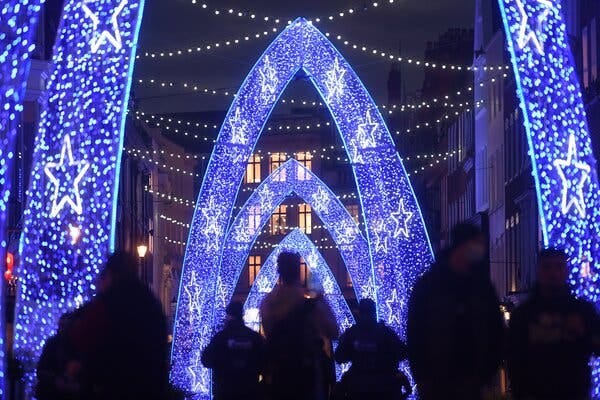
People passing Christmas lights in London on Monday.Credit…Neil Hall/EPA, via Shutterstock
Britons from up to three households will be able to come together and celebrate Christmas under plans announced on Tuesday for a brief relaxation of the rules designed to curb the spread of the coronavirus.
The decision, agreed upon by political leaders in England, Scotland, Wales and Northern Ireland, means that people will be able to move freely around the United Kingdom between Dec. 23 and 27, regardless of whatever local restrictions are in force before those dates.
Those moving to or from Northern Ireland will be given an additional day to travel at both ends of that period to reflect the additional complexity of some of their journeys.
Under the rules, members of up to three households will be able to gather in private homes and outdoor spaces and travel together to places of worship. But the exemption will not allow these larger groups to meet in pubs or restaurants, where normal restrictions will still apply.
Those rules on indoor dining and drinking will vary from region to region. On Monday, the government in England said that when it ends a national lockdown on Dec. 2 the country will be divided into three tiers of restrictions, depending on the severity of the health situation in each area.
However, the government is not expected to announce which regions will be placed in which tier until Thursday.
Michael Gove, a senior British cabinet minister, said that, while “the Christmas period this year will not be normal,” successful talks with Scottish, Welsh and Northern Irish leaders meant that “families and friends will now have the option to meet up in a limited and cautious way across the U.K. should they wish.”
That message was echoed by Mark Drakeford, the First Minister of Wales. “Everyone has done so much to help control the spread of the virus and to save lives,” he said in a statement. “But that has meant many sacrifices, including not seeing family and close friends. We are all looking forward to Christmas and a chance to spend some time with all those we hold dear.”
For Biden, the start of the transition means his battle against the coronavirus begins.


President-elect Joseph R. Biden Jr. and Vice President-elect Kamala Harrris met with a group of mayors from around the United States on Monday.Credit…Anna Moneymaker for The New York Times
Until now, President-elect Joseph R. Biden Jr.’s Covid-19 task force has had to prepare its battle plan without the keys to the government agencies leading the pandemic response.
That changes this week, when Mr. Biden can finally dispatch what are known as landing teams to the Department of Health and Human Services, the Centers for Disease Control and Prevention and the Food and Drug Administration.
They will have prepared the traditional welcome gift: enormous briefing books that detail nearly everything the agencies have been working on for the past four years; lists of friendly lawmakers, budgets, accomplishments, roadblocks; and suggested targets for the new administration.
The president-elect will also inherit something nobody would want: a national crisis that is accelerating by the day. The daily average of new cases in the United States over the past week is at record levels, a staggering 173,000, and growing. Forty-five states are recording sustained caseload increases, and nine are reporting more than twice as many new cases a day as they did two weeks ago.
In the weeks since Election Day, the dire outlook has been tempered by encouraging early results from three major vaccine developers. But Mr. Biden and his top aides have said their ability to effectively plan a pandemic response had been stymied by President Trump’s refusal to acknowledge his victory and the refusal of the head of the General Services Administration to formally authorize the transition process that would grant Mr. Biden’s transition team access to funds, equipment and government data. That argument has been seconded by a growing chorus of senior Republican lawmakers, business executives and other public figures.
On Monday, President Trump’s government finally authorized Mr. Biden to begin a formal transition process. It is supposed to be led by career staff, not political appointees — and the Biden team can expect to find a warm welcome from them, particularly scientists on the team who Mr. Trump has criticized for years.
But in a pandemic, there is no time to waste. The F.D.A. landing team will need to get up to speed on a planned vaccine roll out, as well as the most promising new vaccine candidates and therapeutics. It may also designate a career staff member to be the agency’s acting commissioner if the current one, Stephen M. Hahn, leaves before a replacement can be nominated and confirmed.
At the C.D.C., one of the most pressing issues will be taking over a public education campaign, now in development, to persuade the public to trust — and take — the vaccine.
In the absence of a formal transition, Mr. Biden had been left trying to signal to Americans that he is prepared to take charge of a disjointed federal virus response.
“It doesn’t matter who you voted for, where you stood before Election Day,” Mr. Biden said in Delaware in early November after announcing a coronavirus task force. “It doesn’t matter your party, your point of view. We can save tens of thousands of lives if everyone would just wear a mask for the next few months. Not Democratic or Republican lives — American lives.”
— Sheila Kaplan and Ron DePasquale
NEW YORK ROUNDUP
The organizers of a gigantic Brooklyn wedding will be fined $15,000 for violating pandemic rules.


Thousands attended an ultra-Orthodox wedding in Williamsburg, Brooklyn, on Nov. 8 that flouted health restrictions intended to stop the spread of the virus.
Thousands of ultra-Orthodox Jews gathered to celebrate a wedding inside a cavernous hall in Brooklyn’s Williamsburg neighborhood earlier this month, dancing and singing with hardly a mask in sight. The wedding was meticulously planned, and so were efforts to conceal it from the authorities, who said that the organizers would be fined $15,000 for violating public health restrictions.
The four-hour wedding, held on Nov. 8 by the leaders of the Satmar sect of Hasidic Judaism, is the latest incident in a long battle between city and state officials and members of the ultra-Orthodox community, who prize autonomy, chafe at government restrictions and have frequently flouted guidelines like mask-wearing and social distancing.
In October, state officials announced a series of restrictions in several neighborhoods in Brooklyn and Queens with large Orthodox Jewish populations after the positive test rate in those areas rose above 4 percent. Many residents protested the restrictions, which included the closing of nonessential businesses and limiting capacity at houses of worship.
While the rates in several of these areas have decreased since the implementation of the restrictions, tensions between city officials and area leaders have continued.
Mayor Bill de Blasio announced the fine on Monday night after video of the wedding — and a florid account of the event and the extensive efforts to conceal it appeared in a Hasidic newspaper — drew backlash online. He said additional penalties could be imposed on the organizers.
“We know there was a wedding,” the mayor told the local news network NY1. “We know it was too big. I don’t have an exact figure, but whatever it was, it was too big. There appeared to be a real effort to conceal it. Which is absolutely unacceptable.”
Representatives for the Satmar community did not respond to a request for comment on Tuesday.
Elsewhere in New York:
- Mayor Bill de Blasio announced an agreement with Verizon to offer internet service to half a million households, prioritizing public housing units and community districts known to lack broadband. Mr. de Blasio said he hoped the new access would offer families an alternative way to connect during the holiday season and support students who were scrambling now that schools are closed indefinitely. The effort to bridge the digital divide was first initiated by the former mayor, Michael Bloomberg, who struck an agreement with Verizon in 2008 to make high-speed Fios internet service available to every household in the city. Nine years later, under the de Blasio administration, the city sued the company for failing to fulfill its obligations.
- Gov. Andrew M. Cuomo, facing a barrage of condemnation after discussing his Thanksgiving dinner arrangements in a radio interview, changed his plans. The governor was accused of hypocrisy after he said on Monday that his 89-year-old mother and two of his daughters would be traveling to Albany to join him; he has been pleading with New Yorkers for days to reconsider family gatherings as cases of the virus spike across the nation.
— Liam Stack and Juliana Kim
ADVERTISEMENT
Continue reading the main story
A coalition of African nations launches a clinical trial of treatments for less severe Covid-19 cases.

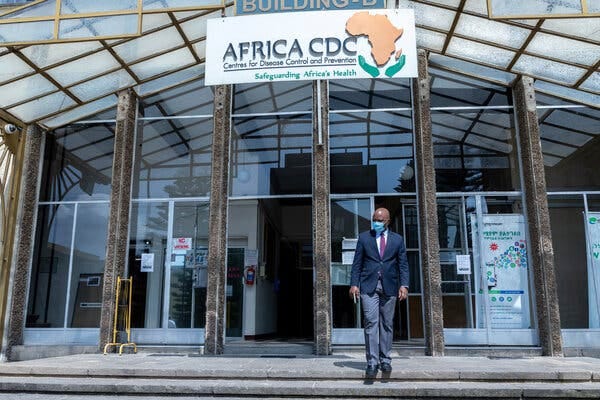
Dr. John Nkengasong, the director of the Africa Centres for Disease Control and Prevention, outside the organization’s headquarters in Addis Ababa, Ethiopia, in September.Credit…Mulugeta Ayene/Mulugeta Ayene, via Associated Press
Thirteen African countries will take part in a clinical trial aimed at identifying treatments that could prevent moderate coronavirus cases from becoming more severe. The randomized trial will be carried out by ANTICOV, a consortium of 26 African and European clinical institutions, and the study’s authors hope the results will lead to fewer hospitalizations, which could overwhelm fragile health systems in the continent.
While many Western countries are preparing plans to distribute a successful vaccine in the coming months, vaccine nationalism and a $4 billion gap in procurement financing in Africa could mean that many countries there experience delays or are left out of the rollout. Governments in these countries are instead exploring other ways to manage any potential case surges.
The clinical trial will explore therapeutic medicines currently used to treat malaria, H.I.V. and certain cancers, among other diseases. Testing is already underway in the Democratic Republic of Congo, with Kenya expected to follow soon. Once individual countries give regulatory approval, the Equatorial Guinea, Ethiopia, Ghana, Guinea, Kenya, Mali, Mozambique, Sudan, and Uganda will also come on board.
Africa has largely avoided the devastating spikes that have swept across Western nations. Experts believe this could be because of younger populations, existing cross-immunity and fewer travel links, among other reasons. Some have suggested numbers may be underreported, although lower hospitalization rates would seem to rule out huge numbers of undetected cases.
But the continent is experiencing a new uptick in cases, and experts warn the holiday season may lead to new outbreaks as families travel or relax social distancing measures.
Africa this week passed the two million cases mark, with the bulk of recorded infections — almost 800,000 — coming from South Africa, the most developed economy in the sub-Saharan region.
GLOBAL ROUNDUP
An Australian airline plans to make proof of vaccination compulsory for travelers, and other news from around the world.


Qantas planes at a domestic terminal at Sydney Airport, Australia, in November.Credit…Loren Elliott/Reuters
Australia’s largest airline, Qantas, is planning to make coronavirus vaccines — when they become available — compulsory for passengers who want to fly internationally, and its chief executive predicted that other airlines would follow.
Alan Joyce, the head of Qantas, said on Monday that the airline was looking at changing its terms and conditions to make vaccines compulsory for those traveling into or out of Australia.
He also said he believed vaccinations as a condition for international air travel would be mandated by more airlines: “I’ve talked to my colleagues at other airlines across the globe, and I think it’s going to be a common theme across the board.”
He said airlines and governments around the world have considered developing an electronic vaccination passport that would certify if passengers were vaccinated and with what vaccine. Mr. Joyce’s comments coincided with an announcement by the International Air Transport Association that it was in the final stages of developing a digital health pass that would provide travelers’ testing and vaccine information to governments and airlines.
The Australian government has said that coronavirus vaccines will be “as mandatory as you can possibly make it.”
Qantas has not finalized any changes since no vaccines are predicted to be available in Australia until early next year, but one British travel company said it would stop selling Qantas flights.
In other news from around the world:
- In an upcoming book, Pope Francis criticizes those who do not wear masks, saying, “It is all too easy for some to take an idea — in this case, for example, personal freedom — and turn it into an ideology.” The pope has himself been criticized for not wearing masks at his public appearances.
- King Felipe VI of Spain has started a 10-day quarantine after coming into close contact with someone who later tested positive for Covid-19. The royal household did not disclose whom the king had met but said in a statement that all of his official activities had been canceled during the quarantine period. The king’s wife, Queen Letizia, and their two daughters have not been quarantined.
- Prime Minister Johnny Briceño of Belize will isolate for two weeks after testing positive for Covid-19, Reuters reported. The country has recorded a total of 5,200 coronavirus cases, according to a New York Times database.
- The parliament of Lithuania installed a new prime minister, Ingrida Simonyte, on Tuesday and then swiftly adjourned for a week because of a surge of coronavirus cases in the country, The Associated Press reported. The former government was heavily criticized over soaring unemployment stemming from the pandemic.
— Yan Zhuang, Natasha Frost, Gaia Pianigiani and Raphael Minder
A Russian vaccine maker reports positive results based on an incomplete trial.

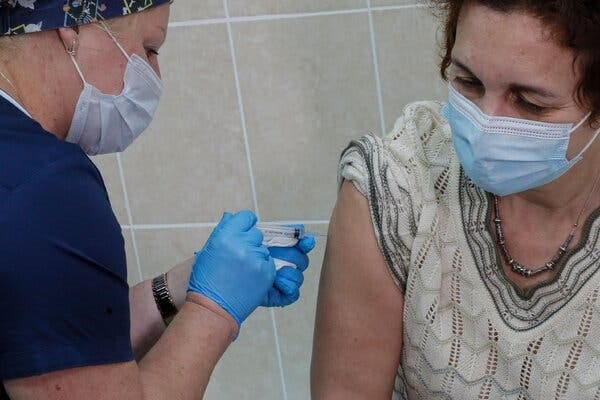
A volunteer received a trial coronavirus vaccine at a hospital in Moscow in September.Credit…Sergei Ilnitsky/EPA, via Shutterstock
The makers of a leading Russian vaccine candidate, Sputnik V, said on Tuesday that it showed an efficacy rate of 95 percent in preliminary results from a clinical trial, which would put it at the same level as or better than three other vaccines that have yielded results in recent weeks.
However, that figure was based on an unspecified small group of volunteers within the ongoing Phase 3 trial of the vaccine, and the vaccine makers did not specify how many people with the vaccine or the placebo got sick. When the trial is done, the company said, they will release more complete data.
While it was hard to immediately assess the efficacy of the vaccine based on the announcement and the fact that the Phase 3 trials are not complete, the news promised to add to the flurry of excitement over the promise that vaccines could bring the coronavirus pandemic to an end.
The American and German team of Pfizer and BioNTech and the American company Moderna have announced efficacy rates of 95 and 94.5 percent, respectively. And AstraZeneca and the University of Oxford said on Monday their vaccine is either 62 percent or 90 percent effective, depending on the manner in which the doses were given.
Russia registered the vaccine for emergency use in August before beginning a clinical trial to measure its efficacy, shortcutting the usual process and drawing international criticism. President Vladimir V. Putin claimed it was the first vaccine in the world to receive government approval.
Russia has marketed its vaccine mostly in former Soviet states and countries with developing economies, saying the cost of one dose will be less than $10 for international markers. Officials said that vaccine makers have received orders for 1.2 billion doses from around 50 countries. The Russian Direct Investment Fund has said that about 10,000 people have been inoculated under the emergency-use approval.
On Nov. 11, the government-backed Russian Direct Investment Fund announced that an analysis of the first 20 volunteers indicated an efficacy rate of 92 percent. On Tuesday, the fund provided a similar estimate with more details. They analyzed 18,794 volunteers who have received both injections of the two-dose regimen; 14,095 got the vaccine and 4,699 got the placebo.
A week after the second dose, they found 39 cases of Covid-19, with only eight of the volunteers who got sick having received the vaccine. Based on the ratio of volunteers who got the vaccine to the placebo, the researchers estimated the efficacy at 91.4 percent.
But in their announcement, the fund said that researchers also looked at an unspecified number of volunteers three weeks after the second dose. In those volunteers, they calculated an efficacy rate of 95 percent.
The researchers will take another look at the results when they reach 78 cases of Covid-19 in the volunteers.
Some experts expressed skepticism about the announcement, which was based on an incomplete dataset and apparently not compiled during a regularly scheduled review of the trial results.
“That’s not how it should be done,” said Dr. John Moore, a virologist at Weill Cornell Medicine. “It seems to me what they’re doing is slicing and dicing and data-dredging to come up with the 95 percent figure.”
In August, the Russian Direct Investment Fund named the vaccine Sputnik V for the first satellite launched by the Soviet Union, though at the time, other vaccines were further along in development.
Russian scientists have begun Phase 3 clinical trials on two other vaccines.
ADVERTISEMENT
Continue reading the main story
In Canada’s second lockdown, schools remain open.


Students at a school in Scarborough, outside Toronto, in September. Despite Toronto’s new coronavirus restrictions, in-person classes will continue.Credit…Carlos Osorio/Reuters
Toronto, the fourth largest city in North America, went into lockdown on Monday. But in contrast to New York and other big American cities, officials are finding it more beneficial to keep schools open.
“We cannot put in-class learning at risk,” Ontario’s premier, Doug Ford, said last week. Along with trying to avoid overwhelming hospitals and protecting older adults in long-term care homes, Mr. Ford said, educating students was “what matters most.”
Mr. Ford’s announcement illustrated how Canada has followed the lead of much of Europe, prioritizing the opening or reopening of schools, while just across the border, many U.S. states have focused on keeping businesses open.
In most places, there are no official thresholds for shutting schools down and there is little appetite to do so, according to Ahmed Al-Jaishi, an epidemiologist who is part of an academic team compiling school outbreaks across Canada. And, despite fears among parents that students would bring the disease home and among teachers that they would get infected, such outcomes have been rare.
Even so, some parents in Toronto have been reluctant to allow their children to return to in-class learning, particularly now, with the city seeing its biggest surge in coronavirus cases since the start of the pandemic. Last week, the city reported a 6.2 percent positive test rate. That is more than double the 3 percent positive test rate in New York that triggered school shutdowns last week.
Most schools across Canada shut in March, when Prime Minister Justin Trudeau asked Canadians to stay home and closed the border. In many cases, the schools didn’t reopen until September, after months of parental complaints, children falling behind in schoolwork and rising concerns about the effects of social isolation.
TORONTO SCHOOLS
Like many places in Europe — and in contrast to big American cities — many school districts in Canada are keeping schools open.
Hong Kong orders all bars and nightclubs to close as infections spike.
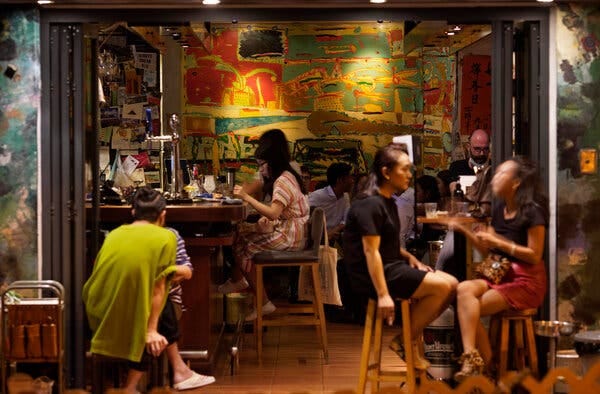

A bar in Hong Kong last month. Bars and nightclubs will be required to close amid an increase in coronavirus cases in the city.Credit…Vincent Yu/Associated Press
Facing a spike in coronavirus infections, the government in Hong Kong ordered all bars and nightclubs to shut starting on Thursday.
The city’s fourth wave of cases has emerged under cooler temperatures and what officials warned of as fatigue after months of social distancing. A cluster that began at a dance studio has since spread to similar venues across the city, bringing infections to another high since the summer.
Sophia Chan, Hong Kong’s health secretary, said that all bars, nightclubs, bathhouses and rented rooms for private parties must close, and that live performances and dancing would be banned. Banquets could have 10 tables at most, with each seating up to four people, she said.
The city’s authorities have toughened and relaxed its social-distancing rules with rises and falls in coronavirus cases. On Tuesday, Hong Kong reported 80 new cases, including 54 linked to the dancers, bringing the cluster that originated at Starlight Dance Club — a ballroom and Latin dance studio — to 187 cases, a health department spokeswoman said.
Also on Tuesday, Hong Kong’s leader, Carrie Lam, defended a plan to pay about $645 to those who test positive and who are in financial difficulty. Critics said the government was giving people an incentive to intentionally infect themselves, but officials have since clarified the eligibility requirements for the payments. Mrs. Lam said it was intended to help those who would lose income as a result of getting infected.
— Elaine Yu
Comments
Post a Comment